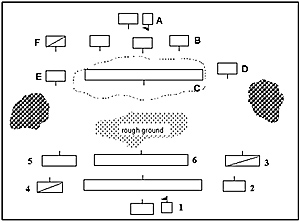There follows a description of a game as it was played which hopefully illustrates some of the features described above.
Deployment
 Having generated two quite well balanced armies from the lists, the Carthaginians certainly had the edge in scouting forces and played as the attacker in this game. I generated the terrain and deployed the defending Romans in two lines anchored on a hill, with velites on the flanks and Triarii in reserve. I chose to play the Romans and use the solo rule to establish the Carthaginian plan. This proved to be 'Circle flank'. Their army was deployed with the bulk of its cavalry and Spanish infantry on the right 'striking' flank, with two elephants supported by lighter troops on the left, whilst in the centre Gallic allies formed the line, supported by a small reserve of Libyan veterans.
Having generated two quite well balanced armies from the lists, the Carthaginians certainly had the edge in scouting forces and played as the attacker in this game. I generated the terrain and deployed the defending Romans in two lines anchored on a hill, with velites on the flanks and Triarii in reserve. I chose to play the Romans and use the solo rule to establish the Carthaginian plan. This proved to be 'Circle flank'. Their army was deployed with the bulk of its cavalry and Spanish infantry on the right 'striking' flank, with two elephants supported by lighter troops on the left, whilst in the centre Gallic allies formed the line, supported by a small reserve of Libyan veterans.
Turn One
The Carthaginian general 'activates' as many of his troops as he can (all except the Reserve and the Numidians on the left). This sets things in motion straight away with both flanks out pacing the centre which is plodding through rougher terrain. The sole Roman move is to activate the cavalry unit on the right to move on to the flank.
Turn Two
On their right, the main Gallic cavalry body charges a unit of skirmishing velites. Both units pass their tests. The velites retire taking a hit, firing at the cavalry to score a hit on them too. The cavalry test for being fired upon and continue their charge, automatically routing the velites. The general activates the third line, the Libyan spears and starts their advance. On the Carthaginian left the elephants attempt to charge the skirmishing velites, taking fire from the retiring lights, the elephants succeed in pressing home their advance and rout the velite unit. Meanwhile, the supporting skirmishers fire upon the Roman cavalry. They do not score any hits but the Romans fail their test, retiring and taking a hit. The cavalry rallies itself and attempts to charge on the elephants (!) They both pass their tests and score a hit each in melee, but again the cavalry are forced to retire, taking more damage. The Roman general activates the second row left flank unit to face the threat now posed by the Gallic cavalry on that wing.
Turn Three
On the Carthaginian right the mounted Gallic allies wheel in to threaten the Roman second line. The closest unit test for an enemy threat and fails, retiring toward the Triarii. In the centre, the Libyan javelinmen reach the foot of the hill and halt as they are within range. They are not able to fire yet as they moved this turn. To the left, the elephants attempt to charge but both fail, retiring and taking hits. In fact, one unit routs altogether. The remainder of the Carthaginian army continues its advance. The Roman cavalry are unable to act, having suffered too many hits to rally, however, an Italian infantry unit of the second line succeeds in charging and routing the remaining elephant unit. The Italian unit on the left regains its composure and moves back to position to threaten the cavalry, who test and pass their test with an instruction to 'halt'.
Turn Four
The Gallic cavalry charge the Italians on the Roman left, causing them to rout and the cavalry to continue toward the Triarii. Both bodies pass their tests and in the resultant melee the Triarii soundly defeat the horsemen, causing one of the units to rout. In the centre the Gallic warbands burst through the skirmish line to charge uphill at the Roman line. The Hastati and Principes hold fast to receive the charge. A combination of better quality troops and much luckier dice throws find the Romans winning by 14 hits to 2. This pushes back the tribesmen who take more hits from the pursuing Romans and lose three out of six units to rout. Meanwhile the Roman left adjusts itself to meet the advancing Spanish and remaining horse, whilst the CinC moves out to the right flank to direct events there.
The End
At this point I decided to call proceedings to a halt, as the Carthaginians, although holding a decent right hook, have lost the bulk of their strength in the centre and left and were unlikely to turn a victory. As I suggested, there are rules for post-battle pursuit and recovery of losses which would be ideal if this game had been part of a campaign.
Key to Map
Roman
A CinC and Triarii
B Principes (and Italians)
C Hastatii (and Italians)
D Velites
E Velites
F Cavalry
Carthaginian
1 CinC and Libyan Spears
2 Spanish infantry
3 Gallic cavalry
4 Numidian mtd skirmishers
5 Elephants and skirmishers
6 Libyan skirmishers
7 Gallic Warbands
Back to Table of Contents -- Lone Warrior #133
Back to Lone Warrior List of Issues
Back to MagWeb Magazine List
© Copyright 2001 by Solo Wargamers Association.
This article appears in MagWeb (Magazine Web) on the Internet World Wide Web.
Other military history articles and gaming articles are available at http://www.magweb.com
